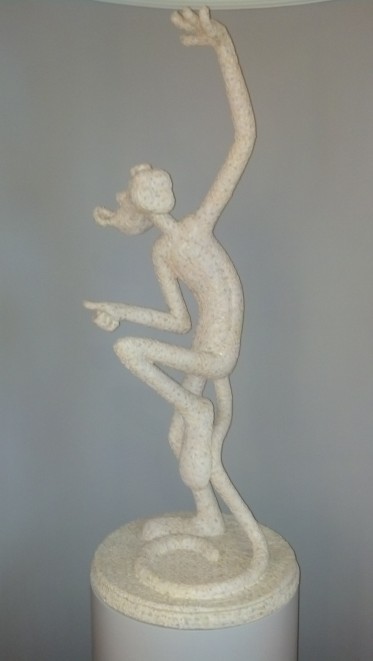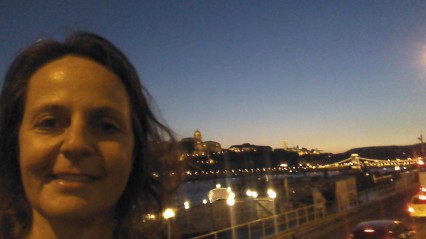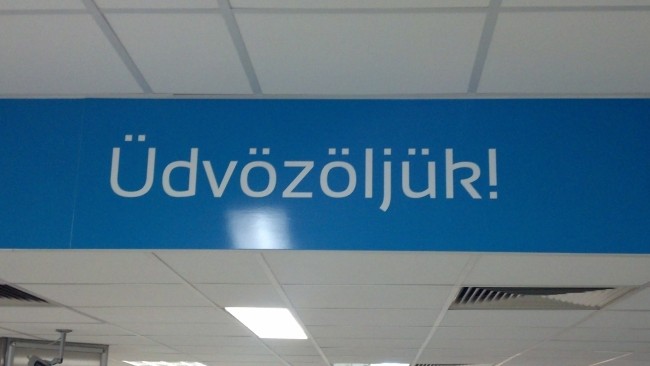Home. Andrassy 19. My last flat in Budapest. Searching for the familiar old creaky door – I hope I can sneak in – I find in its place a glossy black replica, thrown wide open, flanked by potted lollipop topiary and a doorman in a dark suit and earwig. György Gattyán, who made millions on a popular porn website called LiveJasmin, has transformed my building into an impossibly posh clothing store – Giorgio Armani, Bottega Veneta, Valentino and Oscar de la Renta. He named it, quite cheekily, Il Bacio di Style (the Kiss of Style). At least it’s not il Eiaculazione di Style.
I pass through the perfumed air pumped onto the street and cross the threshold. I am sweaty and red-faced and wearing shorts and Tevas. I expect to be escorted out immediately, but the muscle only nods.
What was once dark and soot-covered is now brightly lit and painted a creamy white. All the cracks in the stucco have been smoothed over. In the courtyard two impeccably dressed attendants sit behind a glass case filled with designer sunglasses. The walls emit soothing Euro-style easy listening.
I take the elevator to the fourth floor, where I once lived. Inside the car, there’s a small flatscreen display and more perfumed air. The doors glide open and I step out. My neighbor’s flat – the one facing Andrassy – now sells men’s apparel. Two murmuring young attendants in dark suits smile and nod “hallo” to me. I remedy my slaw jaw and nod back, passing through backlit displays of crisp suits towards my front door.
My apartment now houses a pair of escalators. The “down” escalator starts in my bedroom – where, on their first mission, thieves once stole my beloved but not particularly valuable currency collection – and passes through my living room on its way to the 3rd floor. The “up” escalator starts in my teeny kitchen – where the same thieves, on their second time in my apartment, stole Tupperware, for lack of anything else of value – and crosses through my living room on its way to the top floor, where there is now a chic café/restaurant with views of the Basilica. And that’s it. No longer a place to live or linger, it’s a place from which you must move either up or down.
I return to the wide stairway and start down. After two flights I realize that muscle memory has kicked in. My legs know precisely how many stairs per flight and how high the risers will be. Descending the last flight I pass another patron, on her way up. She’s about 40, maybe 45, but her leathery face betray a tougher life than my own. Her hair is cheap bleached blonde. Tight, short, white cotton dress, with a peephole at the neckline from which protrude freckled, size FFF watermelons. I suspect she is a former, not current, employee.
On my way out, I take a picture of the Pink Panther statue.
The next day’s walking tour of the 6th district finds surprising reminders of things forgotten: metal frames from broken window shades protruding awkwardly from a concrete-block building. Signs advertising Dréher, Borsodi, Soproni. The sharp, spicy aroma of a TV paprika. The 12-foot wide sidewalks on Andrassy, and the 2-foot wide sidewalks along cobbled side streets. The electric hum and rumble of the villamos along the körút.
For the first time in years, I’m gripped by a sudden compulsion to write…and don’t stop!
The crumbling, grey walls are painted with street art, with graffiti. Cafés, photography shops, kerts, and quality – it all add up to a tension and electricity that inspires creativity and seems almost…well, optimistic. My memories of Budapest are of dark cellar sörözö pubs, choked with cigarette smoke, packed with young people hunched over pints of beer. The pints remain, but now they are being drunk at ground level, outside, in “ruin pubs” (aka kerts) that have been tastefully and quirkily decorated to thoroughly out-hipster Brooklyn. By kilometers.
I wander the boiling streets compiling a list of things same and different. Same: air quality. Different: ability to buy “emergency chips & salsa”. Different: little to no dog shit. Same: crumbling walls, soot, graffiti. Different: very cool street art. Same: see-through dresses (though not so many), short skirts, cleavage. Different: an abundance of Thai, Mexican, Indian restaurants. Different: a fair sprinkle of brown-skinned people. Same: strip-tease bars, “szex” shops. Same: acrid cigarette smoke everywhere.
There’s a new modernity, a level of style, that was absent when I lived here: rare or unavailable comforts like yoga studios, salad bars, well-made clothing. All this has been sprinkled on top of the same old city, fixed into place with a coat of clear varnish.
Behind every window, in every courtyard, lit up along the river at night, live possibilities, stories to be invented and told. Perhaps these ghost-stories are what attracted me to this place so many years ago, and still do.
I find myself checking listings as I pass real estate offices: 24 million HUF for an 80-m2 flat? I quickly convert that to $100k for an 800-ft2 apartment. Not bad, but not exactly cheap. I can swing that if I sell my place in Brooklyn. Would I live in the 7th district, which is the center of all the nightlife but also all the packs of drunk Brits on lads’ weekends? Or else maybe the 6th, or 5th. Certainly not Buda again! Actually what would be nice would be a view of the river. Someplace on the top floor, of course, to avoid stomping neighbors.
The next day I keep walking, in the other direction, down Dohany utca, then on Kossuth to the rakpart along the river. I feel like I’m searching for some lost thing that I can’t define until I find it. Jégbufe, where it takes expert Hungarian and 4 bouts of standing in line in order to get a cake and coffee. The Astoria Café, delicately restored with chandeliers and red velvet, which should feel majestic but somehow remains dusty and lost in time. The way Kossuth ut seems to splinter apart as it approaches the rakpart.
It’s as if I’m exploring a city from a recurring dream, familiar yet foreign. Any moment now, the world will stop spinning for the briefest millisecond, everything will come into focus and I will know, wholly and completely, precisely where I am, my unique place in the universe.
But that never happens. Not really, anyway. Instead I rediscover a regular city, one dancing with the ghosts of memories.
I no longer become teary-eyed at the sight of a zöldség gyümölcs. I just go in and buy strawberries. It is now quite normal for me to see Tamás (or Tamás) for a coffee. The voice on the radio saying things like “következö” no longer elicits shivers. I get csokolom’d, and it’s all good.
Home.


